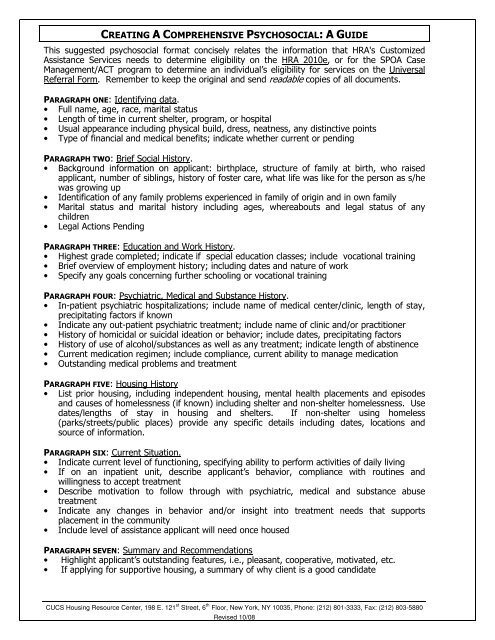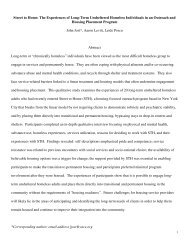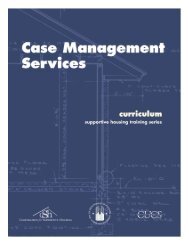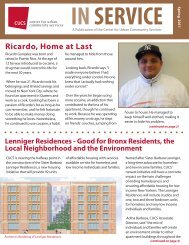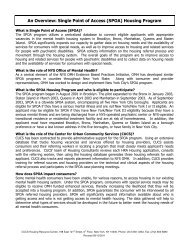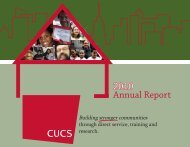CREATING A COMPREHENSIVE PSYCHOSOCIAL: A G ... - cidny
CREATING A COMPREHENSIVE PSYCHOSOCIAL: A G ... - cidny
CREATING A COMPREHENSIVE PSYCHOSOCIAL: A G ... - cidny
Create successful ePaper yourself
Turn your PDF publications into a flip-book with our unique Google optimized e-Paper software.
<strong>CREATING</strong> A <strong>COMPREHENSIVE</strong> <strong>PSYCHOSOCIAL</strong>: A GUIDE<br />
This suggested psychosocial format concisely relates the information that HRA's Customized<br />
Assistance Services needs to determine eligibility on the HRA 2010e, or for the SPOA Case<br />
Management/ACT program to determine an individual’s eligibility for services on the Universal<br />
Referral Form. Remember to keep the original and send readable copies of all documents.<br />
PARAGRAPH ONE: Identifying data.<br />
• Full name, age, race, marital status<br />
• Length of time in current shelter, program, or hospital<br />
• Usual appearance including physical build, dress, neatness, any distinctive points<br />
• Type of financial and medical benefits; indicate whether current or pending<br />
PARAGRAPH TWO: Brief Social History.<br />
• Background information on applicant: birthplace, structure of family at birth, who raised<br />
applicant, number of siblings, history of foster care, what life was like for the person as s/he<br />
was growing up<br />
• Identification of any family problems experienced in family of origin and in own family<br />
• Marital status and marital history including ages, whereabouts and legal status of any<br />
children<br />
• Legal Actions Pending<br />
PARAGRAPH THREE: Education and Work History.<br />
• Highest grade completed; indicate if special education classes; include vocational training<br />
• Brief overview of employment history; including dates and nature of work<br />
• Specify any goals concerning further schooling or vocational training<br />
PARAGRAPH FOUR: Psychiatric, Medical and Substance History.<br />
• In-patient psychiatric hospitalizations; include name of medical center/clinic, length of stay,<br />
precipitating factors if known<br />
• Indicate any out-patient psychiatric treatment; include name of clinic and/or practitioner<br />
• History of homicidal or suicidal ideation or behavior; include dates, precipitating factors<br />
• History of use of alcohol/substances as well as any treatment; indicate length of abstinence<br />
• Current medication regimen; include compliance, current ability to manage medication<br />
• Outstanding medical problems and treatment<br />
PARAGRAPH FIVE: Housing History<br />
• List prior housing, including independent housing, mental health placements and episodes<br />
and causes of homelessness (if known) including shelter and non-shelter homelessness. Use<br />
dates/lengths of stay in housing and shelters. If non-shelter using homeless<br />
(parks/streets/public places) provide any specific details including dates, locations and<br />
source of information.<br />
PARAGRAPH SIX: Current Situation.<br />
• Indicate current level of functioning, specifying ability to perform activities of daily living<br />
• If on an inpatient unit, describe applicant’s behavior, compliance with routines and<br />
willingness to accept treatment<br />
• Describe motivation to follow through with psychiatric, medical and substance abuse<br />
treatment<br />
• Indicate any changes in behavior and/or insight into treatment needs that supports<br />
placement in the community<br />
• Include level of assistance applicant will need once housed<br />
PARAGRAPH SEVEN: Summary and Recommendations<br />
• Highlight applicant’s outstanding features, i.e., pleasant, cooperative, motivated, etc.<br />
• If applying for supportive housing, a summary of why client is a good candidate<br />
CUCS Housing Resource Center, 198 E. 121 st Street, 6 th Floor, New York, NY 10035, Phone: (212) 801-3333, Fax: (212) 803-5880<br />
Revised 10/08
SOME CONSIDERATIONS WHEN DOING A HOUSING <strong>PSYCHOSOCIAL</strong><br />
• Try to find a place where you and the applicant can talk without being overheard by<br />
others, and where you will not be interrupted. Because shelters may offer little privacy,<br />
you may wish to arrange to talk outside, such as in a park or in a coffee shop.<br />
• Remember the information for a psychosocial comes ideally over time with trust and<br />
comfort with the worker. Don’t try to get it all in one sitting<br />
• It is strongly recommended that the applicant be involved in the creation of the<br />
psychosocial. It’s his/her life and he/she will make the ultimate choice as to where and<br />
how to live, or which services they choose to receive. You are participating in this process<br />
together. Where possible, let the applicant participate in the construction and editing. It is<br />
also recommended that the applicant see the psychosocial before it is sent out.<br />
• Try to remain judgment free. The applicant is going to be checking your responses to<br />
what is being said and how he/she is being evaluated. If you indicate negative attitudes<br />
about what is being related, the person is going to be less likely to give accurate or<br />
complete information.<br />
• Respect the person’s pain and privacy. We probe some very personal areas of their lives<br />
as a pre-requisite to creating a psychosocial. Some people may find these questions<br />
invasive or too upsetting to deal with. Pay attention to body language. Are you getting<br />
too many “I don’t knows” You may have gone far enough on the topic and may well<br />
switch to a more neutral tone, or stop altogether.<br />
• Some people are poor historians, and this can be problematic. Some applicants can’t or<br />
won’t remember some details, areas of discussion, or whole decades of time. This may be<br />
conscious or unconscious, plain resistance or genuine absence of memory. You may not<br />
be able to get certain pieces of information that any housing or service provider will ask.<br />
Refrain from pushing too much in certain areas, or guessing. As workers, we gather<br />
information from charts, from the applicant and, again, from our own observations and<br />
work with the individual. It is important to note where information came from especially is<br />
there is a discrepancy between the views or statements of different parties. Some<br />
examples of ways to word discrepancies or gaps in information are:<br />
• Applicant states that…It is the author’s observation that…<br />
• There is no information available on…<br />
• The applicant is a poor historian on specific dates but it can be determined that…<br />
• According to past reports…Applicant denies (or disagrees with) this, however…<br />
• For some people, putting together a time line or other visual aid is very helpful to help<br />
piece together missing information.<br />
CUCS Housing Resource Center, 198 E. 121 st Street, 6 th Floor, New York, NY 10035, Phone: (212) 801-3333, Fax: (212) 803-5880<br />
Revised 10/08


